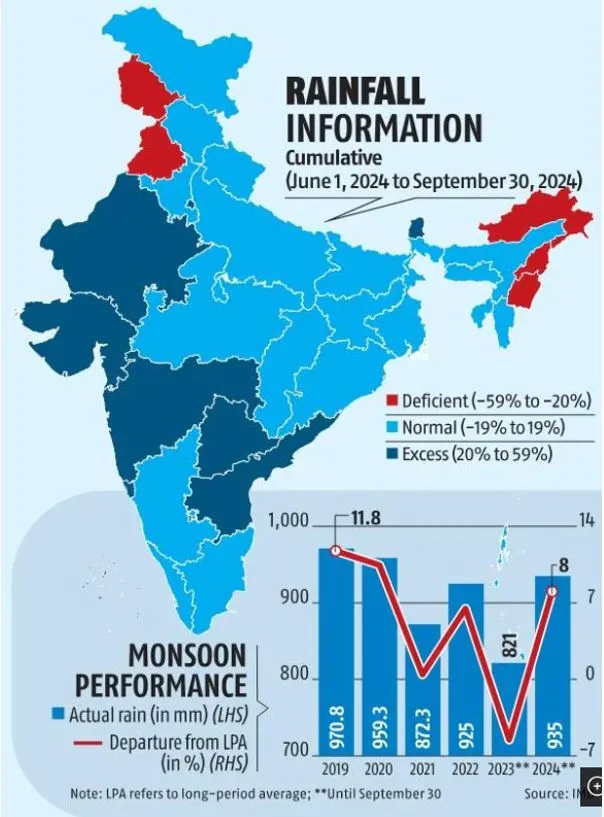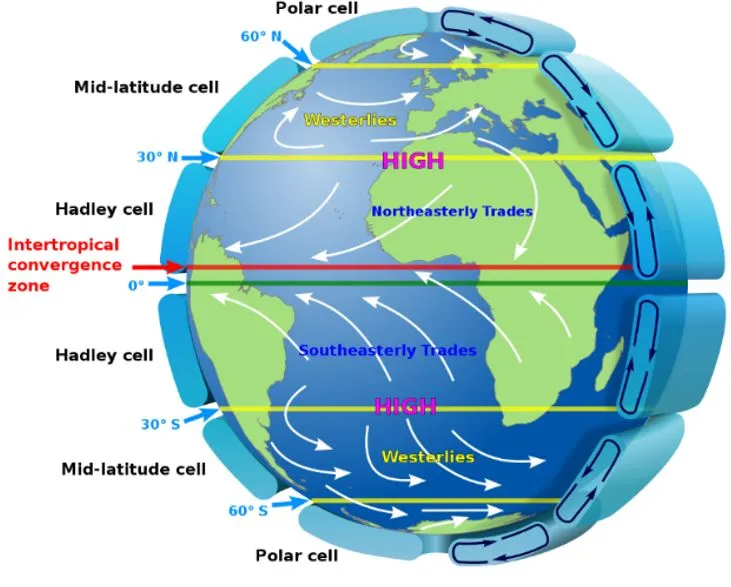

3rd October 2024 (9 Topics)
Context
India’s monsoon season concluded, with the country receiving 8% above-normal rainfall for the June-September period, according to the India Meteorological Department (IMD).
Performance
- Rainfall Statistics: The all-India cumulative rainfall from June to September stood at 935 mm, which is 8% above the normal rainfall of 870 mm. This surplus indicates a strong monsoon season, significantly benefiting agricultural productivity.
- Soil Moisture Conditions: According to the agriculture department, root zone soil moisture levels were either better than or comparable to the average of the past nine years in several key states, including Karnataka, Andhra Pradesh, Tamil Nadu, Telangana, Gujarat, Rajasthan, Uttar Pradesh, most parts of Madhya Pradesh, Chhattisgarh, Punjab, and southern Haryana.
- Regional Variations: However, soil moisture levels were found to be below the nine-year average in northern Bihar, certain areas of Jharkhand, and northern West Bengal, highlighting regional disparities in moisture availability.
- There were 69 low-pressure days this season, compared to the normal of 55.
- Fourteen low-pressure systems formed, and six of these intensified into depressions, against a normal of 5-6.
- The Madden Julian Oscillation, an eastward-moving system of rain-bearing winds and clouds, stayed in a favourable phase longer than usual, sustaining active monsoon conditions.

About Indian Summer Monsoon
- The monsoon season brings in 75% of India’s annual rainfall, watering crops, filling reservoirs, and driving the bulk of India's economy.
- June and July are critical months for planting kharif crops like rice, pulses, oilseeds, and cotton.
- The Indian Summer Monsoon (Southwest Monsoon) is caused by the differential heating of land and water.
- In summer, the Asian land mass heated up to form a low-pressure system, which attracted winds from the Arabian sea and Bay of Bengal, which were at lower temperatures and thus high-pressure systems.
- Energetics theory of the monsoon:
- Solar Radiation and Temperature Differences: The tilt of the Earth's axis leads to varying solar radiation across the globe. During summer in the northern hemisphere, land masses, especially over India and Central Asia, absorb more heat than surrounding oceans, resulting in a significant temperature gradient.
- Development of Low Pressure: The intense heating over the land creates a low-pressure zone. Warm air rises, leading to a reduction in atmospheric pressure at the surface. This contrasts with the relatively cooler, high-pressure regions over the oceans.
- Shifting ITCZ: The intertropical convergence zone (ITCZ), which is a band of low pressure near the equator where trade winds meet, shifts northward during this period. This movement is crucial as it brings moist air from the oceans toward the land.
- Moisture and Rainfall: As the ITCZ moves north and the southeast and northeast trade winds converge, they bring moisture-laden air over the Indian subcontinent. When this air rises due to the low pressure, it cools and condenses, resulting in heavy rainfall characteristic of the monsoon season.

- Impact of the Coriolis Effect: As the southeast trade winds cross the Equator, they are influenced by the Coriolis effect, which causes them to deflect towards the east. This deflection alters their path, resulting in the winds blowing from the southwest toward India. As these winds travel over the warm waters of the Arabian Sea, they pick up significant moisture, making them a vital source of precipitation for the region.
- Arms of Southwest Monsoon: When the moist southwest trade winds reach the Indian peninsula, they trigger the onset of the southwest or Indian summer monsoon. The winds split into two distinct arms:
- Arabian Sea Arm: This arm travels over the Arabian Sea and brings heavy rainfall to India’s western coast, affecting states like Gujarat, Maharashtra, and Kerala.
- Bay of Bengal Arm: The other arm moves over the Bay of Bengal, striking the eastern coast of India and delivering rain to regions such as West Bengal and the southern slopes of the Shillong Plateau.
- Factors such as ocean temperatures, land-sea contrasts, and even global phenomena like El Niño can influence the monsoon's strength and duration.
More Articles


